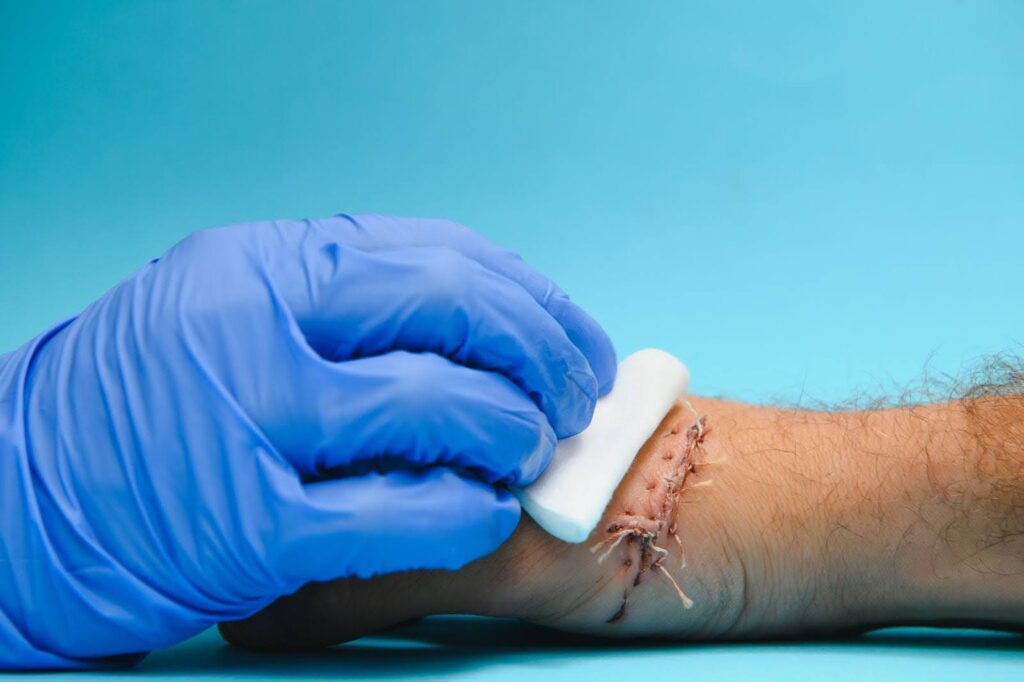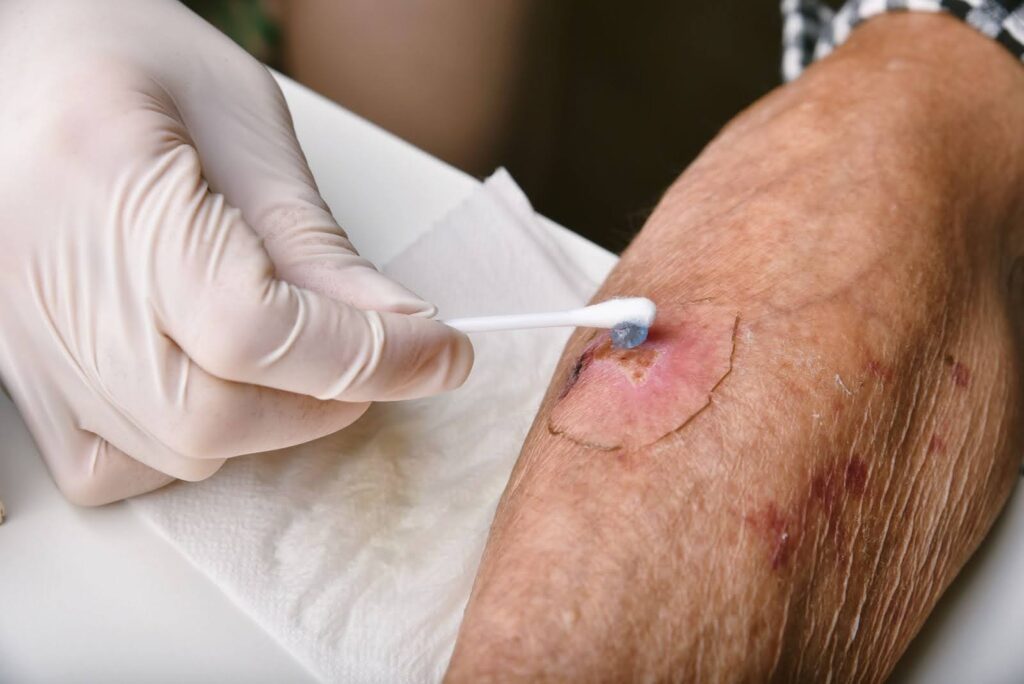
How to Identify a Tunneling Wound Early and Prevent Complications
Some wounds don’t heal the way they should. They start closing on the surface while silently deepening underneath. You might see what looks like progress, but beneath the skin, tissue breaks down. Wound care becomes far more complicated when tunneling begins. For some, it means longer recovery; for others, it calls for advanced options like regenerative therapies.
What is a Tunneling Wound?
A tunneling wound is more than just a deep cut. It travels under the skin and forms a narrow channel, often away from the main wound bed. It can run sideways or downward, hiding tissue destruction beneath what appears to be normal skin. Unlike surface wounds, tunneling wounds don’t heal from the bottom up unless treated correctly.
Defining a Tunneling Wound in Simple Terms
A tunneling wound forms when tissue beneath the skin erodes, creating a channel. This passage can be short or extend several inches in depth. It often occurs in pressure injuries, surgical sites, or infected wounds. The channel isn’t always visible from above, which makes it easy to miss. The tunnel must heal from the inside out to prevent infections or worse.
How Tunneling Wounds Develop Beneath the Skin
The skin may appear to be healing, but the deeper layers continue to break down. As pressure or infection persists, it creates a narrow space beneath the surface. Over time, bacteria accumulate in this area, making healing more challenging. The deeper the tunnel, the harder it is for oxygen and nutrients to reach the site. That sets the stage for chronic wounds and deeper tissue damage.
Common Types of Wounds That Can Start Tunneling
Pressure ulcers are the most common wounds that begin to tunnel. Diabetic ulcers, post-surgical wounds, and infected abscesses can also develop tunnels. Even traumatic injuries that don’t heal properly might tunnel over time. In these cases, the wound surface appears smaller while internal damage grows. That’s why it’s vital not to rely only on what you see.
Early Warning Signs of a Tunneling Wound
Spotting a tunneling wound early can reduce complications. The challenge is that it may look normal at first glance. However, subtle symptoms signal that the body is struggling to heal correctly. Knowing what to watch for makes a real difference.
Visual and Physical Clues You Shouldn’t Ignore
If a wound continues to drain or has irregular edges, pay attention. Sudden depth or craters in the wound bed can be early signs of infection. The skin around the wound may appear swollen or feel firmer than usual. The wound might also appear smaller, but it stays open for too long. These changes could mean the damage has moved beneath the skin.
What Pain Tells You That You Might Overlook
Pain from a tunneling wound can feel sharp or deep. It may occur even when the surface looks mild. If the pain seems disproportionate to the wound size, take it seriously. Discomfort during dressing changes or probing may also suggest tunneling. Trust what the pain tells you; it’s a signal, not a nuisance.
When Redness, Odor, or Drainage Becomes a Red Flag
Unusual drainage, especially foul-smelling, signals trouble inside the wound. If the wound starts leaking yellow, green, or thick fluid, that points to infection. Persistent redness or warmth around the area is another warning sign. These symptoms suggest inflammation or bacteria may be moving deeper. Waiting for treatment could result in more complex tissue destruction.
What Causes a Tunneling Wound to Form
Tunneling wounds don’t appear without reason. They usually stem from a mix of stress, infection, or neglect. Some individuals are more susceptible due to underlying health conditions. Understanding these causes helps prevent the damage from going further:
Pressure and Friction: The Usual Suspects
Long-term pressure on one area cuts off blood flow. Friction from movement then breaks down skin layers. Over time, the tissue weakens and starts to die. The deeper layers suffer first, even if the top looks okay. This silent breakdown eventually creates tunnels under the wound.

Infection and Poor Wound Care
When bacteria invade a wound, they speed up tissue damage. Poor hygiene, dirty dressings, and improper wound cleaning all contribute. Once the infection reaches the lower layers, it begins to form pockets. These pockets create ideal conditions for tunneling. Infection always complicates and slows down the healing process.
How Poor Circulation and Diabetes Raise the Risk
Diabetes can affect how wounds heal, particularly in the legs or feet. Poor circulation means less oxygen reaches the cells, which delays healing and worsens wounds. Nerve damage can also make it hard to feel deeper pain. That’s why diabetic wounds often tunnel without explicit warning.
How to Check for a Tunneling Wound
It’s not enough to look at the surface. You need to know what lies underneath. There are safe and simple ways to detect tunneling, but it takes the right tools and training.
What Trained Professionals Do That You Can Learn
Wound care nurses and doctors often start with visual inspection. They then use sterile instruments to assess depth and direction. They know where to look for signs of tunneling. Their method follows a systematic process that anyone can learn. Regular checks help identify problems before they worsen.
Using a Sterile Probe or Cotton Tip
A gentle probe can reveal tunnels hidden from view. Inserted carefully, it can trace the tunnel’s length and direction. This step should always be done with clean hands and sterile tools. If resistance or pain occurs, stop immediately and seek medical attention. Measuring tunnel depth helps guide treatment.
When to Call in a Specialist
If the wound doesn’t improve aftercare or pain worsens, contact a wound care provider. They have advanced tools, such as wound imaging and debridement kits. Aside from that, they know how to treat stubborn or recurring tunneling wounds. Ignoring signs can delay healing and increase the risk of more severe complications. Professional care often shortens the recovery timeline.
Preventing a Tunneling Wound Before it Starts
Once a tunnel forms, healing becomes harder. That’s why prevention is always a more intelligent choice. Small habits and simple checks can make all the difference.
Cleanliness and Moisture Control at Every Stage
Wounds need to remain clean and slightly moist to heal correctly. Too much moisture can cause maceration, which weakens the skin. On the other hand, dry wounds form crusts that trap bacteria, allowing them to multiply and spread. Gentle daily cleaning and proper dressings can help maintain balance. Clean wounds heal faster and avoid deeper tissue damage.
Why You Shouldn’t Skip Regular Wound Checks
Visual checks help catch tunneling before it worsens. Check wounds daily for changes in size, depth, color, or the presence of fluid. If the wound suddenly appears deeper or stops shrinking, look closer. Having someone assist if the wound is in a hard-to-see area helps. Taking photos over time can also reveal patterns you might miss.
Choosing the Right Dressing for Deeper Wounds
Not all dressings work for every wound. Some wounds need moisture-wicking pads, while others need barrier creams. Hydrocolloid or alginate dressings often support deeper healing. Dressings that stick or trap bacteria can do more harm than good. Picking the right one depends on the wound’s stage, depth, and moisture level.

How to Safely Manage a Tunneling Wound
When a tunneling wound forms, proper management becomes urgent. A surface-level fix won’t help. You need a structured approach to promote deep healing and prevent recurrence.
Debridement and What it Does
Dead tissue blocks new cells from growing. Debridement removes these barriers, allowing healthy tissue to form. It can be done surgically, enzymatically, or with special dressings. Your provider will determine which method is best suited for your case. Without debridement, tunnels often stay open and infected.
Why Packing the Wound Correctly Matters
Packing prevents tunnels from collapsing too quickly at the surface. It allows healing from the bottom up, layer by layer. The packing material also absorbs fluid, keeping the space open. Improper packing can trap bacteria or delay healing. Ask your provider how often to change it based on the condition of your wound.
Keeping Up With Follow-Ups and Monitoring
Healing isn’t a straight path; it needs adjustments. Regular appointments help track progress and adjust treatment as needed. If new drainage or odor appears, don’t wait. Monitoring helps prevent sudden setbacks or infections. A consistent routine builds momentum toward recovery.
Tunneling Wound Complications That Happen Too Often
Missed tunnels can spiral into worse outcomes. What starts small can end in hospitalization or lasting tissue loss. Knowing the consequences gives weight to prevention and daily care.
Hidden Infections That Spread Fast
Infections inside a tunnel can become difficult to treat. Antibiotics may not reach the depth of the wound, and abscesses can form, draining pus and damaging healthy tissue. If not controlled, the infection may spread to the bone. Treating it then requires IV medication and surgical cleaning.
Tissue Death and Long-Term Damage
When a tunnel cuts off blood flow, tissue begins to die. This necrosis can spread, turning a minor wound into a deep crater. If left untreated, it could require grafts or amputation, which would increase the cost of mobility and independence. Healing becomes harder once tissue loss reaches that stage.
Hospitalization Risks and Medical Costs
Deep infections, sepsis, or wound debridement often lead to hospital stays. Recovery time increases, and care expenses accumulate rapidly. Even outpatient wound therapy can be expensive. Insurance may not always cover everything. Preventing complications is not just about health; it also saves money.
Stop Tunneling Wound Progression Before it Worsens
Tunneling wounds don’t fix themselves. You have to stay ahead of the damage. If you see signs of tunneling, take it seriously today. A wound that’s slow to heal, painful, or draining should never be ignored. Daily checks, clean care, and early action can prevent months of pain and cost.
Want trusted guidance on wound healing? Head over to the Stem Health Plus LLC blog for more.
